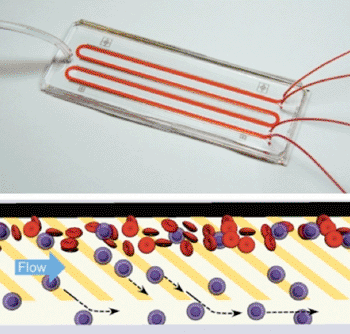Microchip Separates White Blood Cells from Whole Blood
By LabMedica International staff writers
Posted on 14 Aug 2013
A new microchip can quickly separate white blood cells from samples of whole blood, eliminating any preliminary processing steps, which could make it difficult to integrate into point-of-care medical devices.Posted on 14 Aug 2013
The scientists aim is to integrate the microchip into a portable diagnostic device that may be used to directly analyze patient blood samples for signs of inflammatory disease such as sepsis—particularly in regions of developing countries where diagnostic lab equipment is not readily available.

Image: The microfluidic chip works by mimicking the physiological process of 'cell rolling' where patterns of adhesive molecules are used to draw out neutrophils (blue) from a stream of blood (red) into a parallel buffer stream as shown in the bottom panel (Photo courtesy of Suman Bose and Rohit Karnik).
The scientists pumped tiny volumes of blood through the microchip and recovered a highly pure stream of white blood cells, virtually devoid of other blood components such as platelets and red blood cells. The team found that the sorted cells were undamaged and functional, potentially enabling clinicians not only to obtain a white blood cell count, but also to use the cells to perform further genetic or clinical tests.
The chip works by mimicking the physiological process of “cell rolling” where patterns of adhesive molecules are used to draw out neutrophils from a stream of blood into a parallel buffer stream. For blood samples, Prof. Karnik, Rohit Karnik, an associate professor of mechanical engineering at Massachusetts Institute of Technology (MIT; Cambridge, MA, USA) and Suman Bose worked in parallel on a new microchip design. The team etched a pattern of microscopically thin gold stripes, diagonal to the flow of fluid through the chip. They then attached molecules of P-selectin along each gold stripe. Before flowing blood through the chip, the team tested the design with a culture of two types of leukemia cells. Through video imaging, they observed that one cell type was drawn out of the stream, attaching and rolling briefly along a sticky gold stripe before jumping to a neighboring line. Eventually, after a series of jumps and rolls, the cells rolled the rest of the way along a stripe, then into a separate gutter, or channel, where they flowed into a collector.
Rohit Karnik, an associate professor of mechanical engineering at MIT, said that the key to recovering such pure, functional cells lies in the microchip’s adaption of the body’s natural process of cell rolling.
“We believe that because we’re using a very biomimetic process, the cells are happier,” said Prof. Karnik an associate professor of mechanical engineering at MIT, “It’s a more gentle process, and the cells are functionally viable.” Prof. Karnik and colleagues published their results in the July 2013 issue of the journal Scientific Reports.
Related Links:
Massachusetts Institute of Technology










 (3) (1).png)



